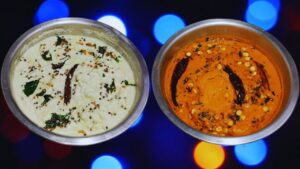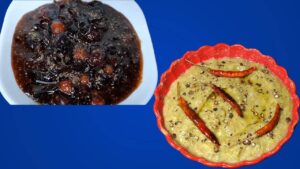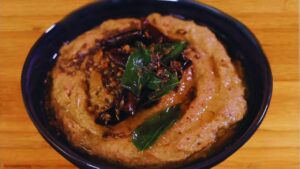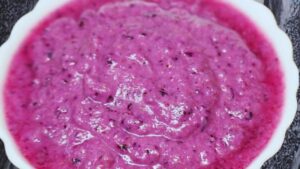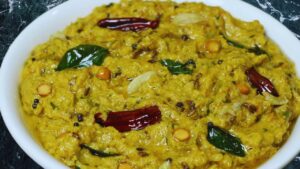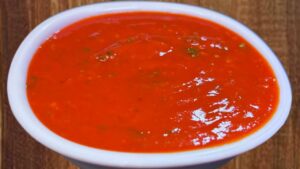Pineapple chutney is made from ripe pineapple, sugar, raisins, and other ingredients. Here are the simple steps to make pineapple chutney at home.

KEY TAKEAWAYS
- Pineapple chutney is a versatile and an ideal accompaniment for various dishes.
- Serve the chutney with grilled meats, rice dishes, cheese platters, or as a dip for veggie spring rolls and chicken sandwiches.
- Store it in an airtight container in your fridge.
- Pineapple chutney tastes sweet, tangy, and spicy with a hint of citrusy undertone.
- Similar chutneys are mango chutney, date chutney, peach chutney, and jamun chutney.
This recipe was shared by a neighbor’s aunt visiting from Assam. They invited us once for lunch at their place when I first tasted this chutney. I never had such a beautiful chutney before. The sweet and sour taste was perfectly balanced and intrigued me. I enquired how she made it and she was happy to tell me the recipe. I made the chutney at home the following weekend.
My husband found it unique, and my sons liked the change. Now, it is our regional-explore recipe and often features in our weekend menu. That day reminded me that guests don’t just bring gifts—they sometimes bring a slice of another state, carrying tastes across cities, into kitchens, and onto plates where stories begin.
How to Make Pineapple Chutney? (Step by Step Guide with Images)
Cutting the pineapple for the chutney:
Step 1: Take one medium size ripe pineapple. Peel the skin using a knife.

Step 2: Remove the ‘eyes’ (receptacle bracts or axillary buds) diagonally. Wash it nicely.

Step 3: Now, cut the pineapple into four pieces.

Step 4: Then, cut away the juicy flesh of the pineapple from the hard and less juicy central part or core of each of all of the four pieces.

Step 5: Finally, chop the pineapple into smaller and finer pieces.

(Pro tip: Cutting the ripe pineapple is very important for proper cooking and the texture of the eventual chutney).
Making the chutney:
Step 6: Take a frying pan or wok, depending on the volume of chopped pineapple pieces, and heat it on a medium flame on your gas stove. Put all of the chopped pineapple in it.

Step 7: Now, add ½ tsp of salt to it.

(Pro tip: You can use regular table salt for your chutney. However, for a better taste I have used black salt).
Step 8: Stir the pineapple to mix the salt nicely to it.

Step 9: Cover the pan and let the pineapple cook for about 5 to 10 minutes until it becomes soft and releases its juice.

Step 10: While the pineapple is cooking, take another frying pan to prepare the sugar syrup. Add 1 cup of sugar in it.

(Pro tip: You may add more sugar depending on the sweetness of the pineapple. Check it beforehand so that your pineapple chutney does not become excessively sweet).
Step 11: Pour ½ cup of water into it.

(Pro tip: Do not put too much water. It will prolong the cooking process and also make the chutney watery).
Step 12: Stir it to mix the sugar with the water nicely.

Step 13: Now, remove the cover to check the pineapple cooking in the other pan. Notice the water in it due to the salt. Stir it continuously and let it cook for another 2 to 3 minutes uncovered so that the water evaporates.

(Pro tip: Turn the flame of your gas stove to high so that the water evaporates quickly and the sugar syrup does not become excessively thick during that time. You may turn the flame to prevent the sugar syrup from becoming thicker if needed).
Step 14: When the water has evaporated and the pineapple pieces have become soft and tender, transfer the cooked pineapple from the pan to the one with the sugar syrup.

Step 15: Stir it nicely to mix the sugar syrup with every piece of the pineapple. Let it cook for another 10 to 15 minutes on a medium flame.

Step 16: Now, add about 2 tbsp of raisins to the content in the pan.

Step 17: Stir and let it cook for another 8 to 10 minutes or so on a medium flame until the sugar syrup becomes thicker, the raisins are cooked nicely, and the chutney gains a nice color and consistency.

Step 18: Though there is no need to add any additional masala to the chutney, you may add about ¼ tsp of the skin or pericarp of a dry red chili as I have at this point.

(Pro tip: Make sure that you remove the seeds of the dry red chili and make a coarse powder of it before adding it to the chutney. You may also cut it into small pieces using a pair of scissors).
Step 19: Stir and mix everything nicely, let it cook for another minute or so until the chutney becomes thicker.

Step 20: Now, turn the flame of the gas stove off, and finally, add 1 tsp of fresh lime juice to the chutney.

Step 21: Give it a final stir, transfer it into a bowl and your delicious homemade pineapple chutney will be ready to be consumed once it is cool.

Recipe Card

Pineapple Chutney
Ingredients
- 1 pice Ripe pineapple medium size
- 1 cup Sugar
- 2 tbsp Raisins
- ¼ tsp Dry red chili skin (pericarp) (optional)
- 1 tsp Fresh lemon juice
- ½ tsp Salt
- ½ cup Water
Instructions
- Take one medium size ripe pineapple. Peel the skin using a knife.
- Remove the ‘eyes’ (receptacle bracts or axillary buds) diagonally. Wash it nicely.
- Now, cut the pineapple into four pieces.
- Then, cut away the juicy flesh of the pineapple from the hard and less juicy central part or core of each of all of the four pieces.
- Finally, chop the pineapple into smaller and finer pieces. (Pro tip: Cutting the ripe pineapple is very important for proper cooking and the texture of the eventual chutney).
- Take a frying pan or wok, depending on the volume of chopped pineapple pieces, and heat it on a medium flame on your gas stove. Put all of the chopped pineapple in it.
- Now, add ½ tsp of salt to it. (Pro tip: You can use regular table salt for your chutney. However, for a better taste I have used black salt).
- Stir the pineapple to mix the salt nicely to it.
- Cover the pan and let the pineapple cook for about 5 to 10 minutes until it becomes soft and releases its juice.
- While the pineapple is cooking, take another frying pan to prepare the sugar syrup. Add 1 cup of sugar in it. (Pro tip: You may add more sugar depending on the sweetness of the pineapple. Check it beforehand so that your pineapple chutney does not become excessively sweet).
- Pour ½ cup of water into it. (Pro tip: Do not put too much water. It will prolong the cooking process and also make the chutney watery).
- Stir it to mix the sugar with the water nicely.
- Now, remove the cover to check the pineapple cooking in the other pan. Notice the water in it due to the salt. Stir it continuously and let it cook for another 2 to 3 minutes uncovered so that the water evaporates. (Pro tip: Turn the flame of your gas stove to high so that the water evaporates quickly and the sugar syrup does not become excessively thick during that time. You may turn the flame to prevent the sugar syrup from becoming thicker if needed).
- When the water has evaporated and the pineapple pieces have become soft and tender, transfer the cooked pineapple from the pan to the one with the sugar syrup.
- Stir it nicely to mix the sugar syrup with every piece of the pineapple. Let it cook for another 10 to 15 minutes on a medium flame.
- Now, add about 2 tbsp of raisins to the content in the pan.
- Stir and let it cook for another 8 to 10 minutes or so on a medium flame until the sugar syrup becomes thicker, the raisins are cooked nicely, and the chutney gains a nice color and consistency.
- Though there is no need to add any additional masala to the chutney, you may add about ¼ tsp of the skin or pericarp of a dry red chili as I have at this point. (Pro tip: Make sure that you remove the seeds of the dry red chili and make a coarse powder of it before adding it to the chutney. You may also cut it into small pieces using a pair of scissors).
- Stir and mix everything nicely, let it cook for another minute or so until the chutney becomes thicker.
- Now, turn the flame of the gas stove off, and finally, add 1 tsp of fresh lime juice to the chutney.
- Give it a final stir, transfer it into a bowl and your delicious homemade pineapple chutney will be ready to be consumed once it is cool.


